The Largest Black Hole In the Known Universe
It’s a huge surprise, and shows up in the most unlikely of places!
“You cannot, in human experience, rush into the light. You have to go through the twilight into the broadening day before the noon comes and the full sun is upon the landscape.” –Woodrow Wilson
We know how most black holes in the Universe form: from the deaths of very massive stars (maybe 20 times the mass of our Sun and up), giving rise to black holes maybe three times our Sun’s mass and upwards. These stars burn through their fuel in their core more quickly than all other stars — in a matter of only a few million years — and when the core can burn no further, they collapse. And nothing inside, not the atoms, not the nuclei, not even the quarks and gluons, can stand up to gravitational collapse if there’s enough mass in there!
By time a star gets up to around 100 solar masses or so, some really strange things begin to happen in the interior. In particular, the innermost core of the star gets so hot that a substantial fraction of the photons in there achieve energies above 511 keV, which is a very important energy threshold. In particular, it’s high enough that when two photons run into one another, they can spontaneously produce electron-positron pairs!
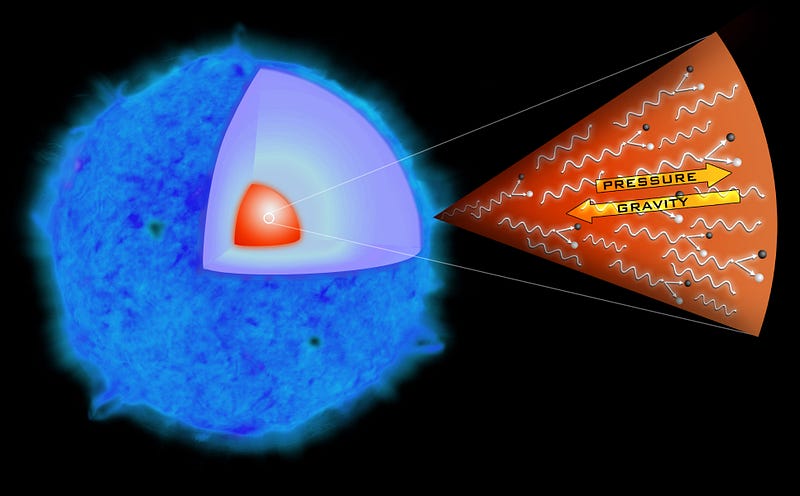
In a normal star, the outward push of pressure and the inward pull of gravitation balance one another, holding a star up. But that pressure mostly comes from photons moving at the speed of light, and if these photons are all-of-a-sudden spontaneously transforming into (slower-moving) particles of matter and antimatter, that pressure will drop, and it may drop catastrophically.
Depending on the mass of the star, the entire thing may experience a runaway fusion reaction, destroying the entire star, or, for the most massive stars, a huge fraction of that mass might collapse down into a black hole! This is what we expect to happen, mind you, for a number of stars in the nearest supermassive star cluster to us: R136 in the Tarantula Nebula.
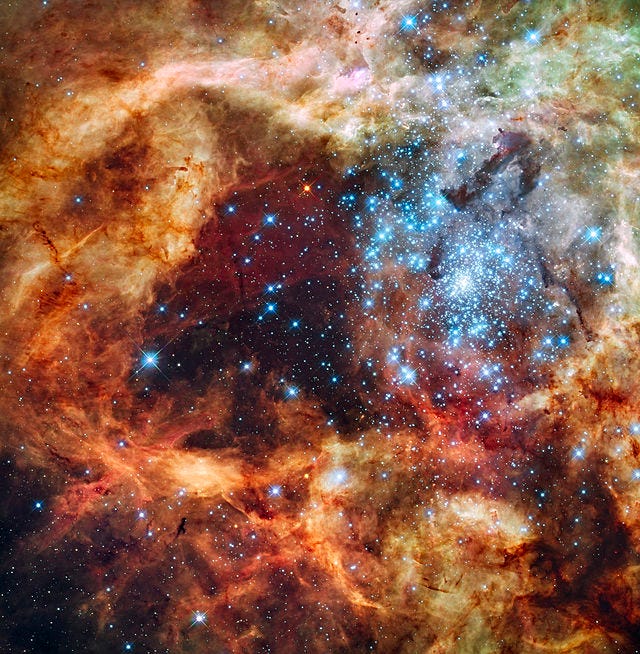
The Universe has been around for a long time, and has had many opportunities to create large, supermassive stars that live, die, and become black holes. At the centers of galaxies, in particular, those black holes have the opportunity to merge and build up. Over time, most galaxies acquire supermassive black holes as a result, including our own, which has one with a mass of some four million Suns. We can measure this almost directly, for our own galaxy, by watching a number of well-identified stars orbit a point from which no light is emitted, but a mass of 4,000,000 Suns is required for those orbits to exist!
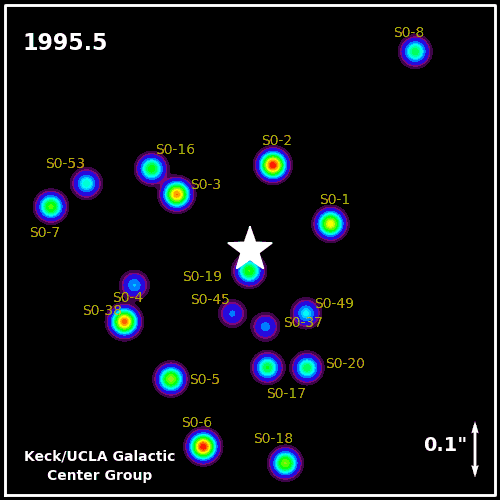
You’ve got to remember that there are between 200-and-400 billion stars in our galaxy, meaning our black hole is about 0.1% of our galaxy’s total mass. That’s a small fraction but a huge number, objectively. Now, consider that our galaxy is hardly one of the biggest, and our black hole is actually on the smaller end of the supermassive scale.
There are great galactic behemoths out there, and the largest one that’s relatively close to us is Messier 87, the giant galaxy at the center of the Virgo Cluster!
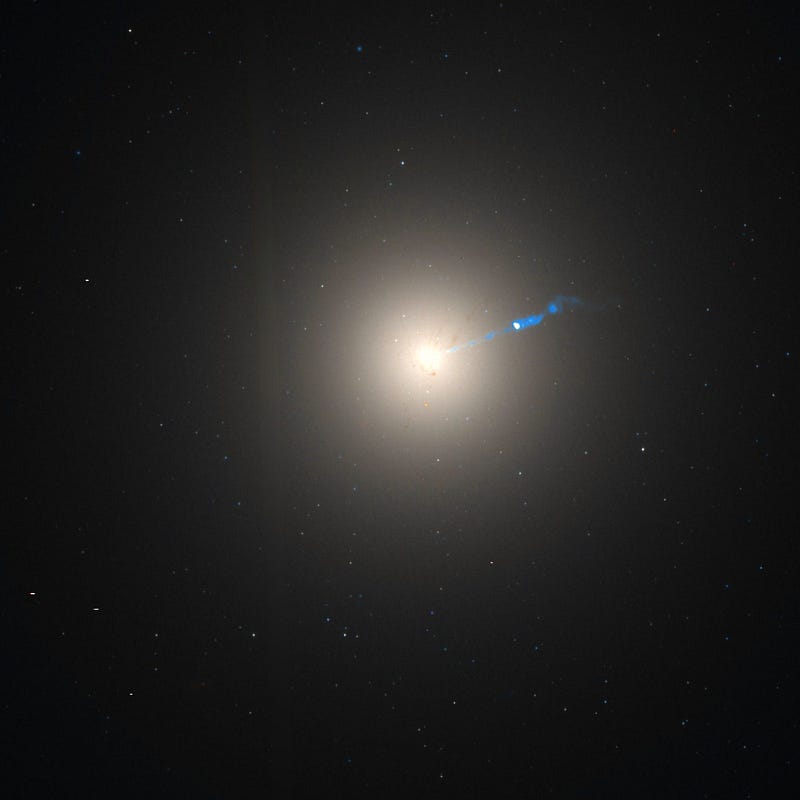
This is the biggest galaxy close to us with a mass of around 200 times our own. You might think it’s odd that there’s a “line” feature coming out of it. As best as we can tell, that’s a relativistic jet of matter some 5,000 light-years long, and it’s being ejected by the center of the galaxy! The only thing we know of that could accomplish such a feat is a supermassive black hole, and one much larger than our galaxy holds.
In fact, if we want to measure the mass of this black hole, the best hope is to look in the X-ray, with Chandra.
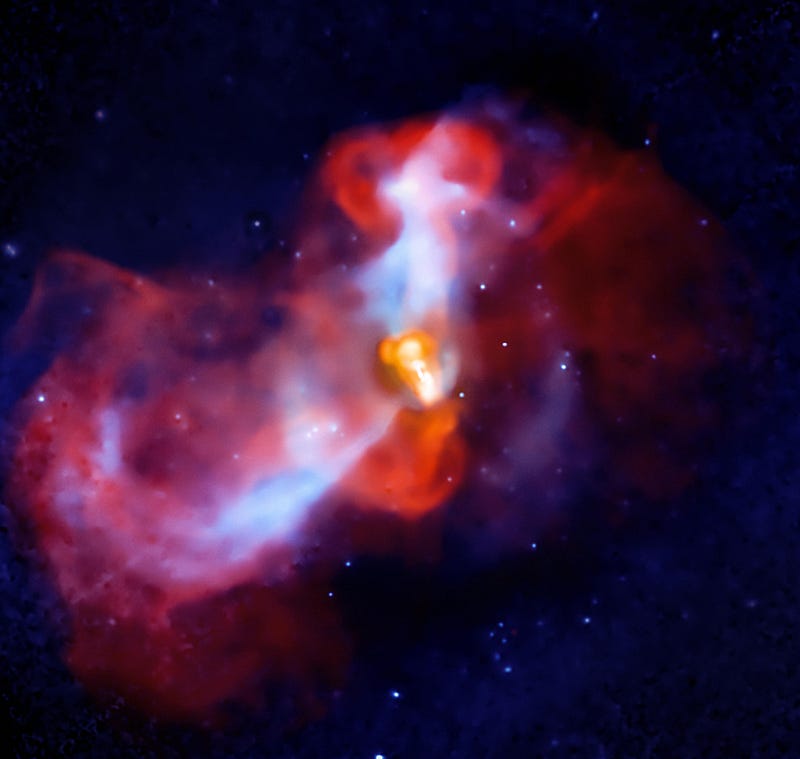
The most recent measurements indicate that there’s a supermassive black hole in here of 6.6 billion solar masses, a phenomenal number and again a mass that’s 1500 times as large as our Milky Way’s central giant! We can confirm this by studying the ejecta in the radio, from the VLA.
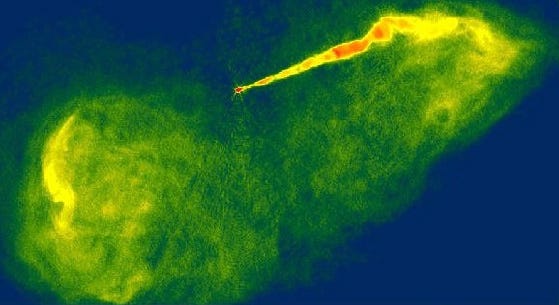
What’s most remarkable (to me) is that the previous best estimate of the central black hole’s mass came from measuring flares from the center of M87, and that gave us a black hole mass estimate of 6.4 billion Suns. In other words, we really understand what’s going on in here!
Before you go thinking that Messier 87 is some crazy anomaly, let me show you a wide-field view of a large portion of the Virgo cluster.
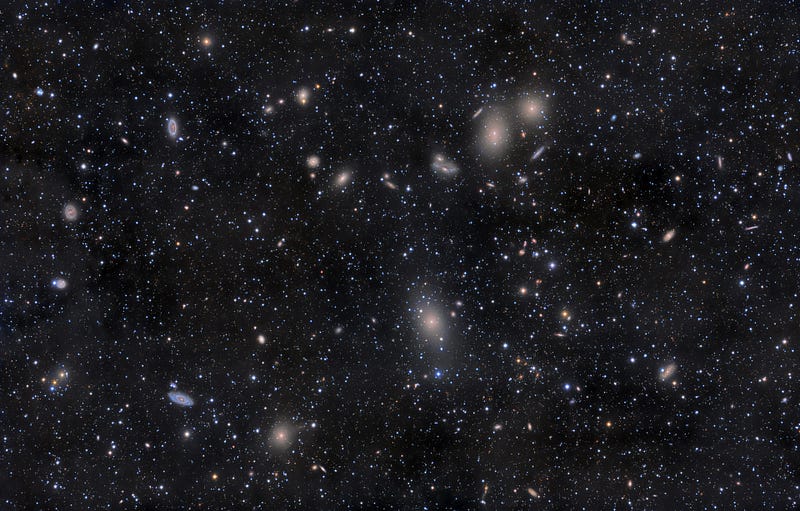
In addition to M87, there are a number of other giant elliptical galaxies in that same vicinity of space, including M84, M49, and M60, all of which have black holes exceeding a billion solar masses. In general — although there is some variation — elliptical-and-lenticular galaxies are thought to form by the repeated major mergers of spirals, their central black holes eventually merge, and that same approximate figure of 0.1% of the galaxy’s total mass can be found in a central black hole.
So, you might think that if you wanted the largest mass black hole possible, you’d look to the largest mass galaxy possible. Well, we can try!
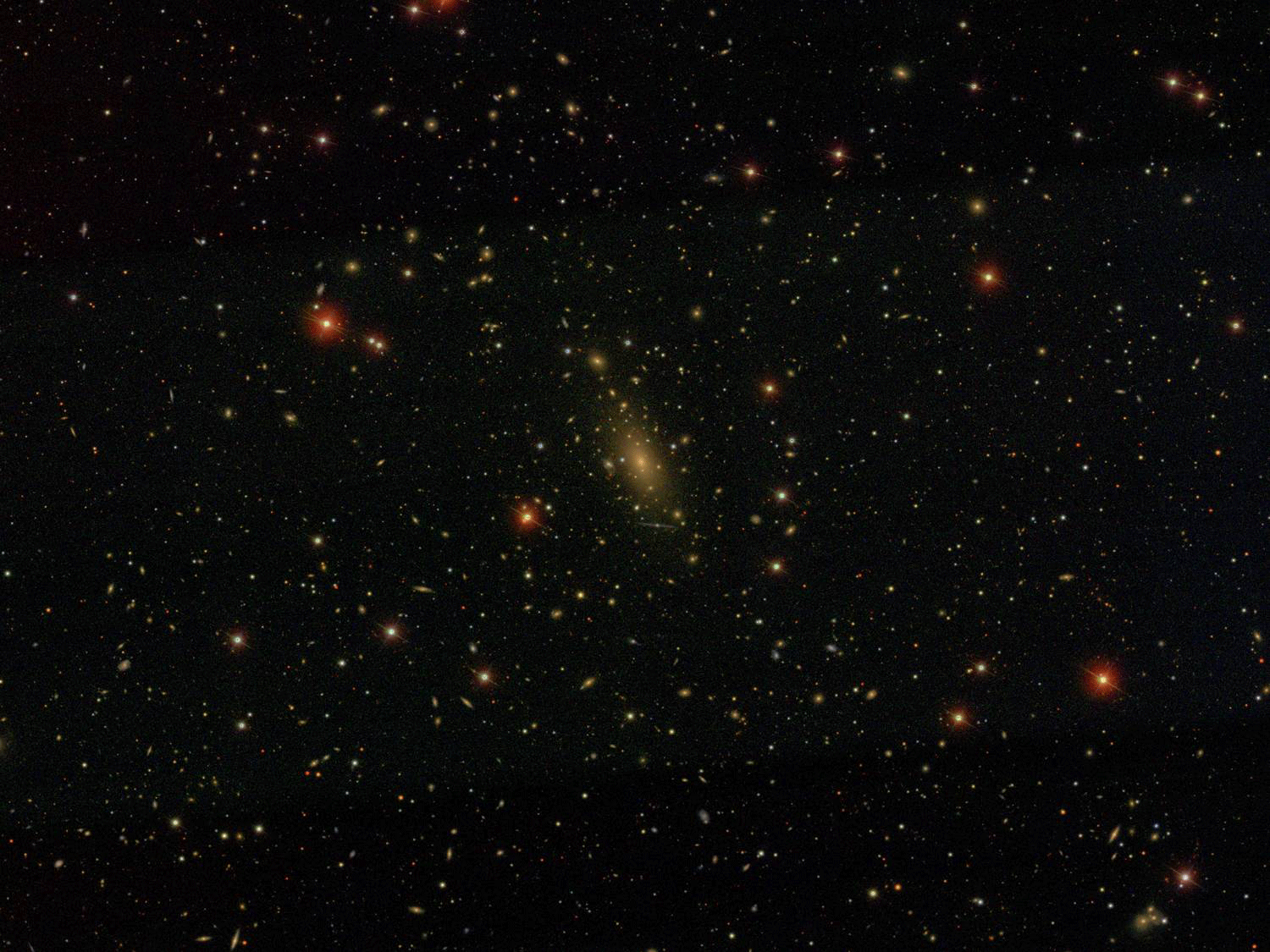
This is galaxy cluster Abell 2029, located 1.07 billion light-years distant, or some 20 times farther away than the Virgo Cluster. At the center of this lies the largest known galaxy in the Universe: IC 1101. This is a galaxy that extends for 2 million light-years away from its central core in its largest direction, many times the size of Messier 87 and with the largest known mass of any galaxy in the Universe. In fact, it extends for nearly twice the distance separating the Milky Way from Andromeda! Including dark matter, it comes in with 100 trillion Solar Masses, or nearly the mass of the entire Virgo Cluster combined. (If you do a google image search for the size of this galaxy, you will find some terribly wild exaggerations of this galaxy; beware.)
But what about its black hole?
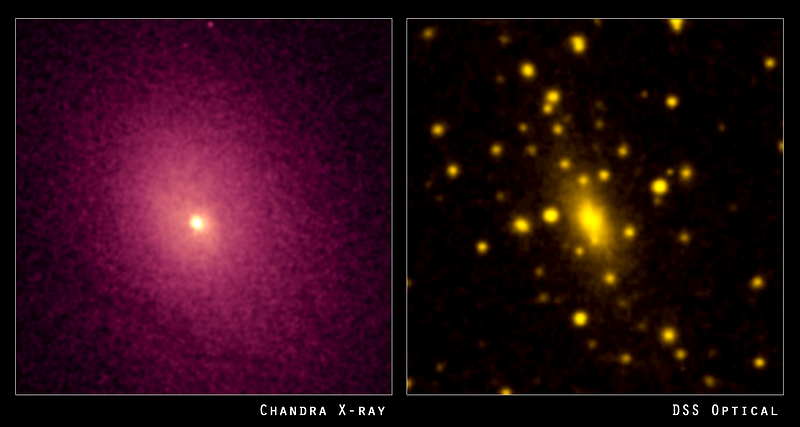
If only we knew; it’s too far away, not active enough and our present space-based equipment isn’t good enough to measure the parameters we normally measure with enough accuracy. Maybe someday! And if I had to bet, I would guess that this is, in fact, where the largest black hole in the known Universe currently resides.
It’d be a smart bet, but I also wouldn’t be surprised if I was totally wrong on that account, and the reason why will surprise you!
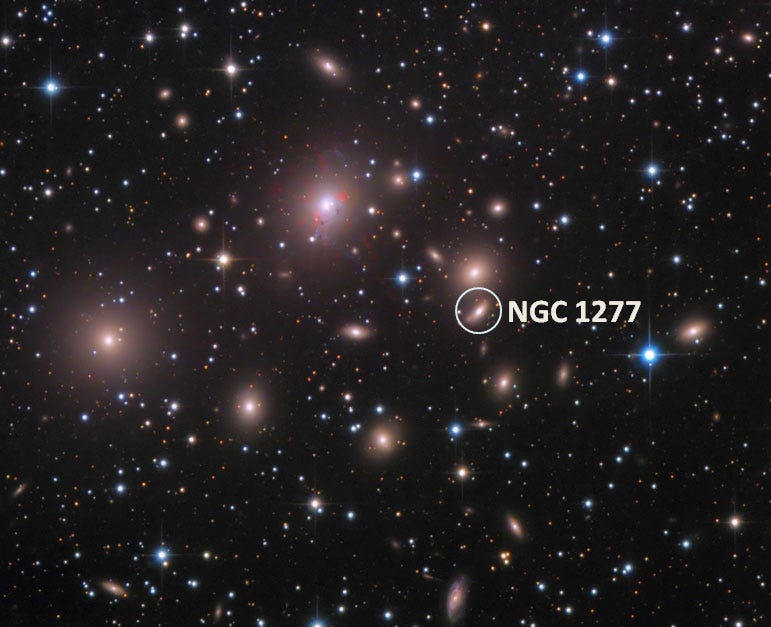
This is the Perseus cluster, a much less impressive cluster of galaxies than Abell 2029. The large, active galaxy at the center is absolutely spectacular, but the galaxy highlighted is very non-descript: NGC 1277. This cluster of galaxies is relatively close — at a little over 200 million light-years away — and NGC 1277 is very typical of that, 220 million light-years distant. It’s not the biggest galaxy, it’s not the most elliptical, it’s not the most massive, it’s not the brightest. In fact, based on the stars in there, with a total mass of around 120 billion solar masses, it’s even a little less massive than the Milky Way!
But if you can spatially resolve the gas in the core of a galaxy (and this is close enough for us to do it), you can measure how it’s moving, kinematically. The faster the speed rises as you move in, the better you can reconstruct what its central mass — condensed down to a point — must be. (Many more details here.)
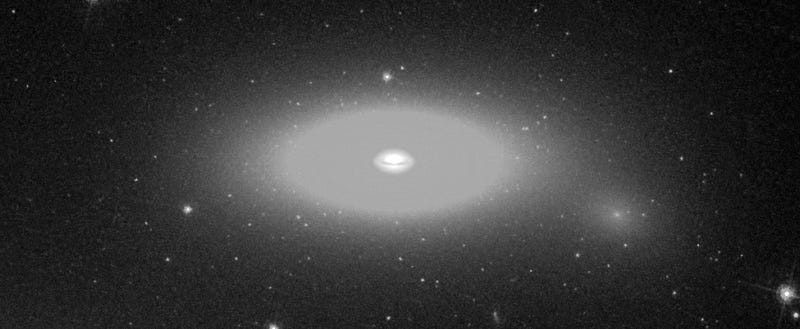
For this galaxy, there must be a central black hole with a staggering 17 billion Solar masses, or a whopping 14% of the stellar mass of the galaxy! This is an unprecedented number; not only is this by far the most massive black hole we’ve ever found, but this is also the largest ratio of a black-hole-to-host-galaxy mass we’ve ever seen! There are others with highly unusually large ratios — NGC 4486B and Henize 2-10 — but these are smaller galaxies.
So sure, it’s conceivable that the largest galaxy in the Universe contains the largest black hole, but it’s also possible that the record holder will turn out to be a non-descript lenticular galaxy that simply happens to have a tremendous black hole there for reasons we don’t fully understand!
On the other hand — within the best error bars of our measurement capabilities — there’s another candidate for largest black hole in the known Universe, and it’s very different from the one in NGC 1277.
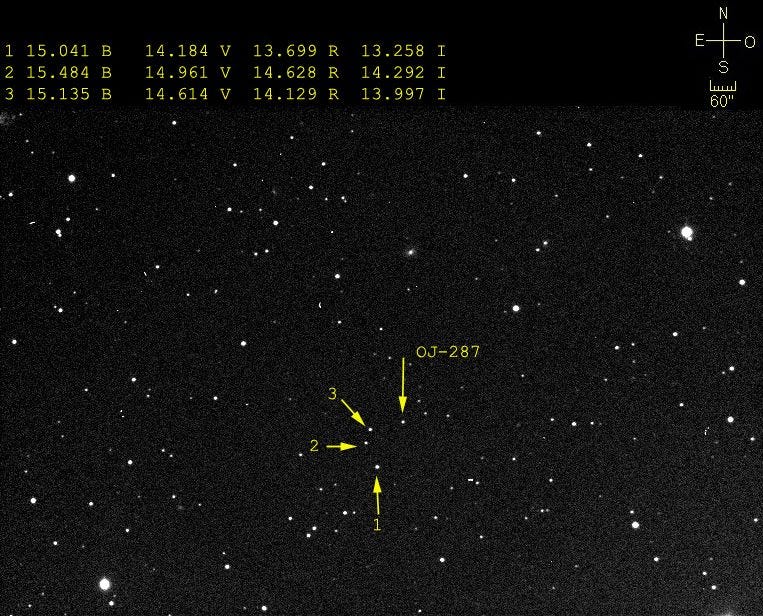
See that point-of-light highlighted, above? That’s known as OJ 287, and it’s a special class of object known as a Blazar, which is a compact, extragalactic radio source that are some of the most energetic objects in the Universe. It’s a special type of quasar — an active galaxy — that’s thought to have one of its powerful jets pointed right at us!
Now, you’ve got to remember how objects like active galaxies work in general: they’re supermassive black holes that are feasting on material like stars, gas, and other cosmic phenomena. Because they rip structures apart gravitationally and accelerate them incredibly intensely, they’re very messy eaters. Although this is one major way that black holes grow, it’s also a major way that the Universe alerts us to their presence!

This object’s brightness varies periodically — with an 11-12 year period — and emits outbursts with a narrow, double peak associated with its maximum brightness. It can be viewed spectacularly in both the radio and in the X-ray, and what we find is consistent not only with there being a central, supermassive black hole of extraordinary magnitude, but with another, smaller supermassive black hole in close orbit around it.
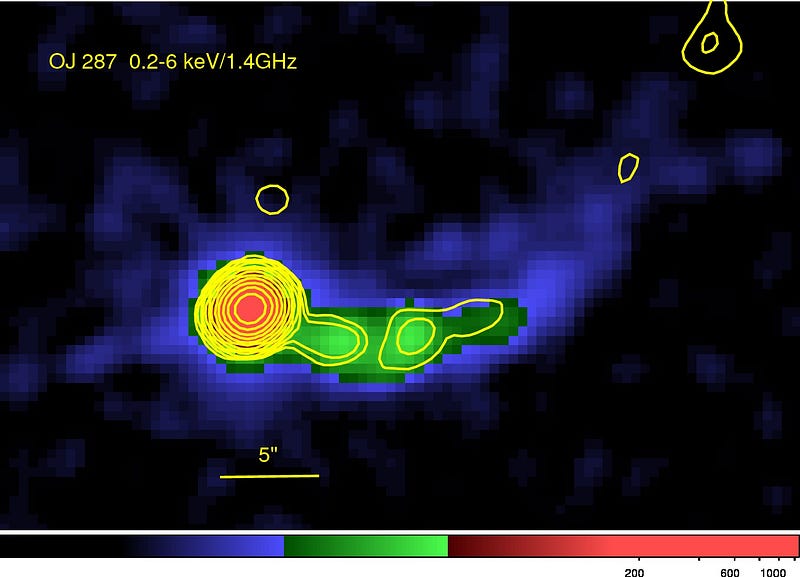
contours: 1.4 GHz radio image from the Very Large Array.
Around 3.5 billion light-years away, this galaxy is estimated to contain the largest black hole presently known, at 18 billion solar masses. (Although, the error bars for this one and NGC 1277’s overlap substantially.) But the most spectacular part of this galaxy — and why we’re able to learn so much about it’s central region — is because there’s a 100 million Solar mass black hole (that’s 25 times larger than the one at the Milky Way’s core) that’s orbiting the even larger one!
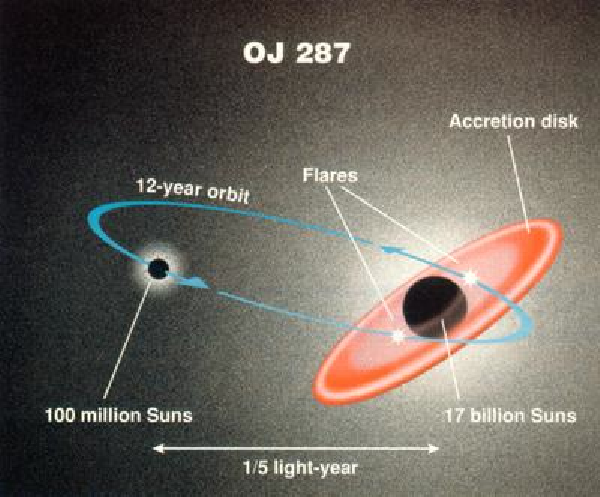
With an orbit that’s more than 300 times the scale of Pluto’s around the Sun that completes in just 12 years, this system — if we’re modeling it correctly — will provide one of the greatest tests of General Relativity of all-time. While the ellipse that Mercury’s orbit makes around the Sun precesses at a rate of 43″-per-century due to relativistic effects (where 1° is 3600″), this smaller black hole should precess at 39°-per-orbit, and should inspiral in to the larger one in a timeframe of just a few thousand years!
And those two galaxies, the nearby (and small) NGC 1277 and the ultra-distant OJ 287, house what we know of as the largest black holes in the Universe. There are surely larger ones out there, but it will take both serendipitous configurations and time — and better radio-and-X-ray telescope equipment — to help us find them!
Update: NGC 1277, the nearby, small-ish galaxy that Remco van den Bosch did such outstanding work on has a video associated with it, pointed to me by van den Bosch himself! Have a look at enjoy!
Enjoyed this? Leave a comment at the Starts With A Bang forum on Scienceblogs!





